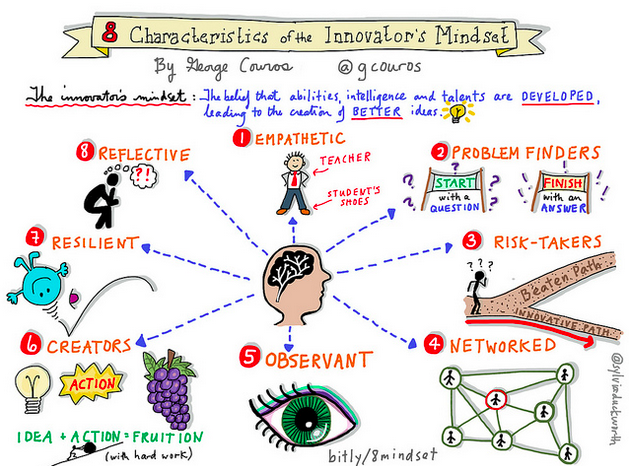 The innovator’s mindset is dynamic, adaptable and aims at problem solving. So far, so good. However, there are other factors as important, as shown in the graph above.
The innovator’s mindset is dynamic, adaptable and aims at problem solving. So far, so good. However, there are other factors as important, as shown in the graph above.
First of all, empathy. To reach an effective education you need to be empathic, the same attitude that makes the teacher feel in the student’s shoes, listen to him, understand his ambitions and dreams and find a way to show him how to grab them. Then, other abilities are relevant too: observation, connection with others, the capacity to take unbeaten paths, creating value.
Education 3.0, the tech and interconnected one, cannot miss these elements out. Every student is a dense system of knowledge and connections, of experiences and dreams. Every one of these factors should inevitably go along with the ability to interact with the latest tendencies of the running and transforming world.
Katie Martin, of the University of San Diego, writes on her blog about the need to create a “culture of transformation”, instead of a culture of innovation. Martin thinks that we do not necessarily need to transform the role of teachers, rather create a culture of transformation – one of a positive change and attitude – that inspires and empowers teachers to innovate in the pursuit of providing optimal learning experiences for their students.
Innovation is not an inherently positive concept. In other words, it does not automatically identify something absolutely better than before. In some cases, the simple transformation of just a few parts of the “product” on the basis of the audience who will be using it could be a great innovation itself. Innovating can also mean to make some processes more efficient or rapid, not always inventing brand new products. It can be about teaching by making a more intense use of the available technology. It can, and must, be about giving one more chance.
The purpose of education is all about building new bridges to allow opportunities to run across. Without bridges, knowledge stays in silos: they can be more or less high, but they are still disconnected with the others. Communication and circulation of ideas are priorities of transformation that make innovation useful and fruitful. Without them, innovation remains a valid exercise of limited experimentation.